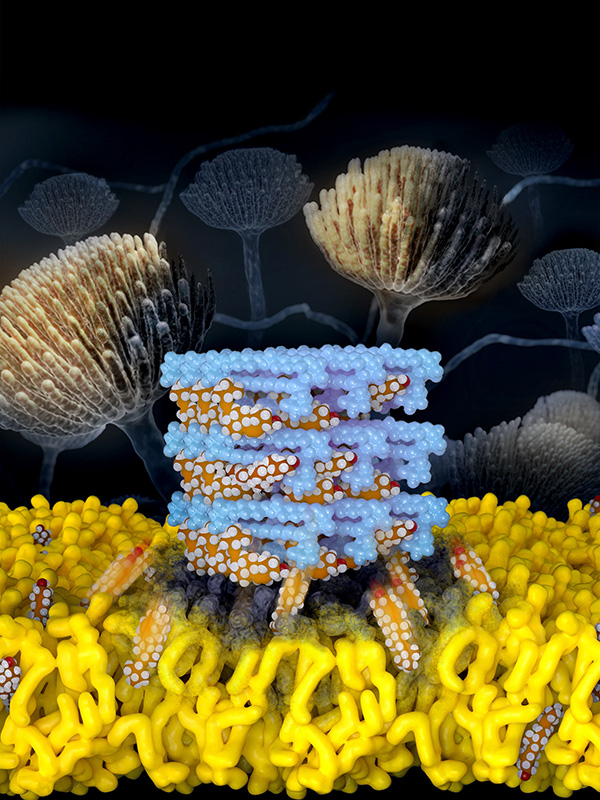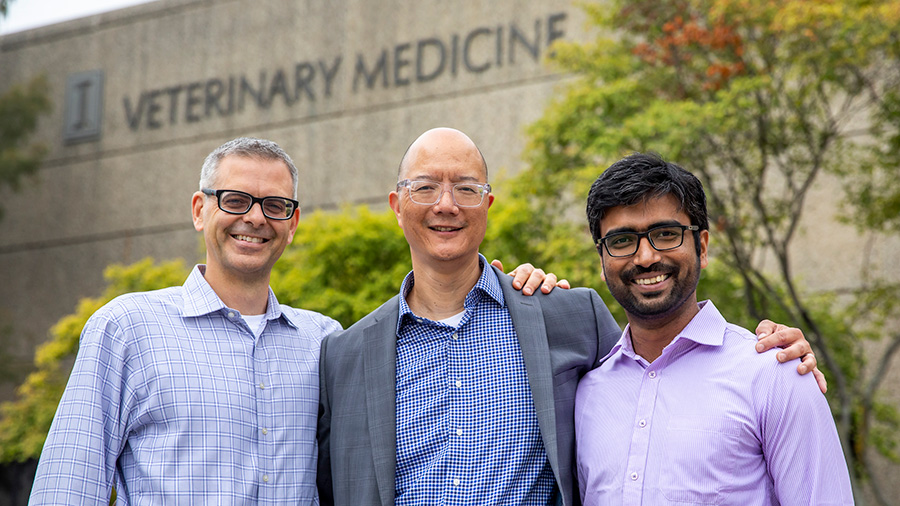A new antifungal molecule, devised by tweaking the structure of prominent antifungal drug Amphotericin B, has the potential to harness the drug’s power against fungal infections while doing away with its toxicity, researchers at the University of Illinois Urbana-Champaign and collaborators at the University of Wisconsin-Madison report in the journal Nature.
Amphotericin B, a naturally occurring small molecule produced by bacteria, is a drug used as a last resort to treat fungal infections. While AmB excels at killing fungi, it is reserved as a last line of defense because it also is toxic to the human patient – particularly the kidneys.
“Fungal infections are a public health crisis that is only getting worse. And they have the potential, unfortunately, of breaking out and having an exponential impact, kind of like COVID-19 did. So let’s take one of the powerful tools that nature developed to combat fungi and turn it into a powerful ally,” said research leader Dr. Martin D. Burke, an Illinois professor of chemistry, a professor in the Carle Illinois College of Medicine and also a medical doctor.
“This work is a demonstration that, by going deep into the fundamental science, you can take a billion-year head start from nature and turn it into something that hopefully is going to have a big impact on human health,” Burke said.
‘Going Deep’: Uncovering the Mechanism of AmB
Burke’s group has spent years exploring AmB in hopes of making a derivative that can kill fungi without harm to humans. In previous studies, they developed and leveraged a building block-based approach to molecular synthesis and teamed up with a group specializing in molecular imaging tools called solid-state nuclear magnetic resonance, led by professor Chad Rienstra at the University of Wisconsin-Madison. Together, the teams uncovered the mechanism of the drug: AmB kills fungi by acting like a sponge to extract ergosterol from fungal cells.

In the new work, Burke’s group worked again with Rienstra’s group to find that AmB similarly kills human kidney cells by extracting cholesterol, the most common sterol in people. The researchers also resolved the atomic-level structure of AmB sponges when bound to both ergosterol and to cholesterol.
“The atomic resolution models were really the key to zoom in and identify these very subtle differences in binding interactions between AmB and each of these sterols,” said Illinois graduate student Corinne Soutar, a co-first author of the paper.
“Using this structural information along with functional and computational studies, we achieved a significant breakthrough in understanding how AmB functions as a potent fungicidal drug,” Rienstra said. “This provided the insights to modify AmB and tune its binding properties, reducing its interaction with cholesterol and thereby reducing the toxicity.”
Assessing Promising Derivatives
Armed with the information from the NMR studies, the Illinois team began synthesizing and testing derivatives with slight changes to the region that binds to ergosterol and cholesterol, while also boosting the kinetics of the ergosterol-removing process to maintain efficacy.
Enabled by collaborators and facilities at the Carl R. Woese Institute for Genomic Biology and U. of I. veterinary clinical medicine professor Dr. Timothy Fan, the researchers tested the most promising derivatives – first with in vitro assays, quickly assessing the efficacy in killing fungi; then moving to cell cultures and eventually live mice, assessing toxicity.
One molecule, dubbed AM-2-19, stood out from the rest.
(Continue reading below sidebar.)
Tim Fan on his role in the Amphotericin B study
Although my own research is focused on cancer, my understanding of cell biology and appreciation of drug exposure and response relationships has allowed me to participate in the broader swath of research into important clinical barriers that affect humans and animals. The University of Illinois campus truly fosters a collaborative, multidisciplinary approach to tackling the large biomedical challenges facing society.

Photo by Fred Zwicky
My partnerships with world-class chemists including Paul Hergenrother and Martin Burke in the Department of Chemistry go back more than 15 years. They are both working to address the urgent need for improving treatment of life-threatening pathologies, including cancer and infectious diseases. Both chemists have research programs that seek to develop novel antifungal or antimicrobial drugs to fight pathogens that are newly emerging or that have become resistant to existing therapeutics.
For the study reported in Nature, Marty Burke and three additional principal investigators, including myself, were awarded a five-year R01 grant from the National Institute of Allergy and Infectious Diseases. That grant built upon the work his team has been doing for the past 20 years on the drug Amphotericin B, used to treat invasive fungal infections.
Based on information they characterized on how AmB interacts with cell membrane sterols, Burke’s team synthesized a large number of novel molecules designed to make it less toxic to human cells while retaining its toxicity to fungal cells. Part of my role was to help rapidly identify which of these new drug candidates showed the most promise of being both safe and effective, using studies in rodents. Two anatomic pathologists from our college with interest in research, who are also co-authors on the paper, performed histological examinations of tissue from the rodents to confirm that the antifungal molecure tested did not cause kidney damage.
It’s exciting to be part of this landmark paper that could revolutionize human medicine. We are anxiously awaiting results from the Phase 1 clinical trials with SF100. If SF100 is proven to be safe and effective for treating invasive fungal infections, the team of Burke and Fan would continue to collaborate toward generating novel oral formulations of the antifungal molecule, which could be transformative in treating invasive fungal infections in parts of the world where intravenous treatment is inaccessible.
“This molecule is kidney-sparing, it is resistance evasive and it has broad spectrum efficacy,” said postdoctoral researcher Arun Maji, a co-first author of the paper. “We tested this molecule against over 500 different clinically relevant pathogen species in four different locations. And this molecule completely surprised us by either mimicking or surpassing the efficacy of current clinically available antifungal drugs.”
The researchers tested AM-2-19 in human blood and kidney cells to screen for toxicity. They also tested AM-2-19 in mouse models of three common, stubborn fungal infections and saw high efficacy.
From ‘Terrible’ to ‘Terrific’
“During my medical rotations, we called AmB ‘ampho-terrible,’ because of how hard it was on patients,” Burke said. “Decoupling the efficacy from the toxicity turns ‘ampho-terrible’ into ‘ampho-terrific.’ We are very excited about the potential we are seeing, although clinical study is needed to see if this potential translates to people.”
As a first step toward clinical application, AM-2-19 has been licensed to Sfunga Therapeutics and recently entered Phase 1 clinical trials. Sfunga Therapeutics also supported the work in part, and Burke received consulting income and equity in the company.
The National Institutes of Health supported this work. Illinois chemistry professor Taras Pogorelov also was a coauthor of the work. Fan also is affiliated with the Carle Illinois College of Medicine and the Cancer Center at Illinois. Burke and Pogorelov are affiliated with the Beckman Institute for Advanced Science and Technology.
By Liz Ahlberg Touchstone, Biomedical Sciences Editor, Campus News Bureau
Feature photo by Michelle Hassel: Drs. Martin Burke, Timothy Fan, and Arun Maji pose outside the Veterinary Medicine Basic Sciences Building.
Read the full article here: https://news.illinois.edu/view/6367/1103251063




